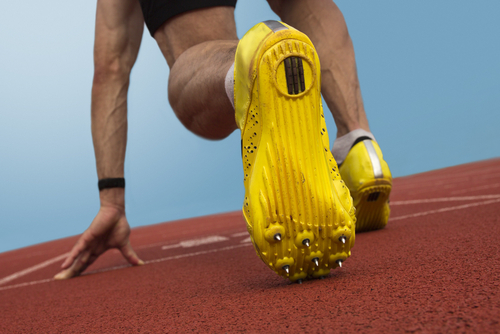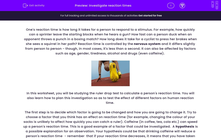One's reaction time is how long it takes for a person to respond to a stimulus. For example, how quickly can a sprinter leave the starting blocks when he hears a gun? How fast can a person duck when an opponent throws a punch in a boxing match? How long does it take for a cyclist to press her brakes when she sees a squirrel in her path? Reaction time is controlled by the nervous system and it differs slightly from person to person - though, in most cases, it's less than a second. It can also be affected by factors such as age, gender, tiredness, alcohol and drugs (even caffeine).

In this worksheet, you will be studying the ruler drop test to calculate a person's reaction time. You will also learn how to plan this investigation so as to test the effect of different factors on human reaction time.
The first step is to decide which factor is going to be changed and how you are going to change it. Try to choose a factor that you think has an effect on reaction time (for example, changing the colour of your socks is unlikely to affect how quickly you can catch a ruler). Caffeine (in coffee, tea, cola etc.) can speed up a person's reaction time. This is a good example of a factor that could be investigated. A hypothesis is a possible explanation for an observation. Your hypothesis could be that drinking caffeine will reduce a person's reaction time - remember that if your reaction time decreases, it means that you have taken less time to react, in other words you have reacted more quickly. You will need a partner for this investigation and they are going to have their reaction time tested.
Method:
1. Sit your partner (person one) down on a chair with their forearm resting flat and in line with the edge of a table. The arm they rest should be their dominant arm (so if they are right-handed, it should be their right arm) and their hand should be overhanging the edge.
2. Person two (this is you) should hold a ruler vertically and straight above person one's hand. The 0 cm mark should be in line with the thumb and index finger of person one.

3. Without warning, person two needs to drop the ruler and person one needs to try to catch it as quickly as possible.
4. Record the number just above person one's thumb after they have caught the ruler. The closer the number is to zero, the faster the reaction time person one has.
5. Repeat this a further ten times and calculate the mean distance the ruler fell.
6. Use a conversion table (like the one below) to find out your reaction time. Find the distance in centimetres and read across to find the corresponding value in seconds. For example, if the mean distance was 20 cm, person one's reaction time will be 0.21 seconds.
7. Person one now needs to have a caffeinated drink (such as 400 ml of strong coffee). After ten minutes, repeat steps 1 to 6.
| Drop distance (cm) | Reaction time (s) | Drop distance (cm) | Reaction time (s) |
| 10 | 0.14 | 17 | 0.19 |
| 11 | 0.15 | 18 | 0.19 |
| 12 | 0.16 | 19 | 0.20 |
| 13 | 0.16 | 20 | 0.21 |
| 14 | 0.17 | 21 | 0.21 |
| 15 | 0.18 | 22 | 0.22 |
| 16 | 0.18 | 23 | 0.22 |
You can now compare the reaction time before and after consuming caffeine, and decide if your hypothesis was correct. The last (and probably most important thing) is to control as many variables as possible during this investigation to make sure the test is fair:
The same person needs to catch the ruler throughout the investigation.
Person one needs to always use the same, dominant hand (don't switch halfway through.)
The height from which the ruler is dropped always needs to be the same.
Make sure that person one has not had any caffeine, carried out heavy exercise or had a very bad night's sleep before the experiment is started.
Are you ready to have a go at some questions now?








